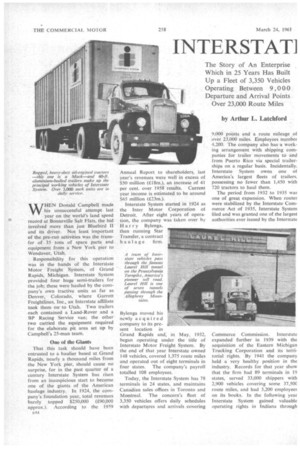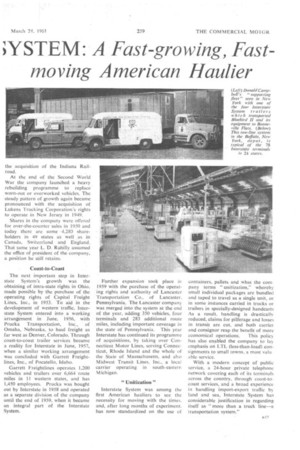INTERSTAT1
Page 78

Page 79

If you've noticed an error in this article please click here to report it so we can fix it.
;YSTEM: A Fast-growing, Fast
moving American Haulier
The Story of An Enterprise Which in 25 Years Has Built Up a Fleet of 3,350 Vehicles Operating Between 9 ; 000 Departure and Arrival Points Over 23,000 Route Miles by Arthur L. Latchford
WHEN Donald Campbell made his unsuccessful attempt last year on the world's land speed record at Bonneville Salt Flats, the bid involved more than just Bluebird II and its driver. Not least important of the pre-run activities was the transfer of 35 tons of spare parts and equipment from a New 'York pier to Wendover, Utah.
• Responsibility for this operation was in the hands of the Interstate Motor Freight -System, of Grand Rapids, Michigan. Interstate System provided four huge semi-trailers for the job; these were hauled by the company's own tractive units as far as Denver, Colorado, where Garrett Freightlines, Inc., art Interstate affiliate took them on. to Utah. Two trailers
each contained a Land-Rover and a BP Racing Service van; the other two carried the equipment required for the elaborate pit area set up by Campbell's 25-man team.
One of the Giants
That this task should have been entrusted to a haulier based at Grand Rapids, nearly a thousand miles from the New York pier, should cause no surprise, for in the past quarter of a century Interstate System has risen from an inauspicious start to become one of the giants of the American haulage industry. In 1924, the company's foundation year, total revenues barely topped $250,000 (£90,000 approx.). According to the 1959 a44 Annual Report to shareholders, last year's revenues were well in excess of • $50 million (£18m.), an increase of 41 per cent. over 1958 results. Current year income is estimated to be around $65 million (£23m.).
Interstate System started in 1924 as the Inter Motor Corporation at Detroit. After eight years of operation, the company was taken over by Harry Bylenga, then running Star Transfer, a contract haulage firm.
Bylenga moved his newly acquired company to its present location in Grand Rapids and, in May, 1932, began operating under the title of Interstate Motor Freight System. By the end of that year Interstate owned 148 vehicles, covered 1,375 route miles and operated out of eight terminals in four states. The company's payroll totalled 108 employees.
Today, the Interstate System has 78 terminals in 24 states, and maintains Canadian sales offices in Toronto and Montreal. The concern's fleet of 3,350 vehicles offers daily schedules with departures and arrivals covering 9,000 points and a route mileage of over 23,000 miles. Employees number 4,200. The company also has'a working arrangement with shipping companies for trailer movements to and from Puerto Rico via special trailerships on a regular basis. Incidentally, Interstate System owns one of America's largest fleets of trailers, possessing no fewer than 1,450 with 720 tractors to haul them.
The period from 1932 to 1935 was one of great expansion. When routes were stabilized by the Interstate Commerce Act of 1935, Interstate System filed and was granted one of the largest authorities ever issued by the Interstate
Commerce Commission. Interstate expanded further in 1939 with the acquisition of the Eastern Michigan Trucking Corporation and its territorial rights. By 1941 the company held a very healthy position in the industry. Records for that year show that the firm had 89 terminals in 19 states, served 33,000 shippers with 2,900 vehicles covering some 37,500 route miles, and had 3,200 employees on its books. In the following year Interstate System gained valuable operating rights in Indiana through
the acquisition of the Indiana Railroad.
At the end of the Second World War the company launched a heavy rebuilding programme to replace worn-out or overworked vehicles. The steady pattern of growth again became pronounced with the acquisition of Lukens Trucking Corporation's rights to operate in New Jersey in 1949.
Shares in the company were offered for over-the-counter sales in 1950 and today there are some , 4,280 shareholders in 49 states as well as in Canada, Switzerland and England. That same year L. D. Rahilly assumed the office of president of the company, a position he still retains.
Coast-to-Coast
The next important step in Interstate System's growth was the obtaining of intra-state rights in Ohio, made possible by the purchase of the operating rights of Capital Freight Lines, Inc., in 1953. To aid in the development of western traffic. Interstate System entered into a working arrangement in June, 1956, with Prucka Transportation, Inc., of Omaha, Nebraska, to haul freight as far west as Denver, Colorado. Through coast-to-coast trailer services became a reality for Interstate in June, 1957, when a similar working arrangement was concluded with Garrett Freightlines, Inc., of Pocatello, Idaho.
Garrett Freightlines operates 1,200 vehicles and trailers over 6,664 route miles in 11 western states, and has 1,450 employees. Prucka was bought out by Interstate in 1958 and operated as a separate division of the company until the end of 1959, when it became an integral part of the interstate System.
• Further expansion took place in 1959 with the purchase of the operating rights and authority of Lancaster Transportation Co., of Lancaster, Pennsylvania. The Lancaster company was merged into the system at the end of the year, adding 350 vehicles, four terminals and 283 additional route miles, including important coverage in the state of Pennsylvania. This year Interstate has continued its programme of acquisitions, by taking over Connecticut Motor Lines, serving Connecticut, Rhode Island and the whole of the State of Massachusetts, and also Midwest Transit Lines, Inc., a local carrier operating in south-eastern Michigan.
" Unitization "
Interstate System was among the first American hauliers to see the necessity for moving with the times and, after long months of experiment. has now standardized on the use ol containers, pallets and what the company terms "unitization," whereby small individual packages are bundled and taped to travel as a single unit, or in some instances carried in trucks or trailers in specially-designed handcarts As a result, handling is drastically reduced, claims for pilferage and losses in transit are cut, and both carrier and consignor reap the benefit of more economical operations. This policy has also enabled the company to lay emphasis on LTL (less-than-load) consignments to small towns, a most vain able service.
With a modern concept of public service, a 24-hour private telephone network covering each of its terminals across the country, through coast-tocoast services, and a broad experience in handling import-export traffic by land and sea, Interstate System has considerable justification in regarding itself as "more than a truck line—a transportation system."




































































































































